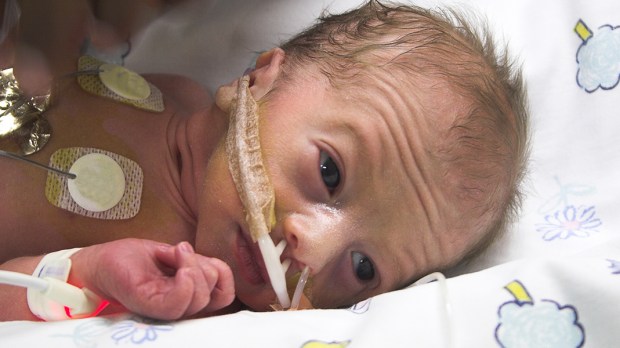New artificial wombs could save preemies
Each year, about 10% of the babies born in the United States are delivered prematurely at younger than 37 weeks gestation. Medical science continually pushes the limits of viability, and today, premature babies born as young as 22 to 23 weeks have as much as a 50 percent chance of survival. But while these babies have a better chance than ever at surviving, they remain at high risk (90 percent) for long-term disability, including cerebral palsy and chronic lung disease. This reality may change in coming years, however, as researchers at the Children’s Hospital of Philadelphia (CHOP) have announced the invention of a “womb-like device” that could be a game-changer in the care of premature infants.
Unlike the “dry” environment of incubators – the best intervention that medical science currently has to offer these little ones – the CHOP researchers’ “Biobag” is filled with lab-created amniotic fluid. Mimicking the environment of the womb, the bags have the potential to one day provide preemies with the precious additional weeks needed for continued development, especially of their tiny lungs, which simply aren’t prepared to breathe air just yet. So far, the researchers have successfully kept premature infant lambs (which are developmentally similar to human infants in the womb) alive in the bags for up to 28 days. What’s more, the lambs continued to develop and grow both physically and neurologically while inside the Biobags.
Based on the success of the bags with the lambs, the CHOP researchers are now in talks with the FDA about the possibility for future human trials. Far from promising the replacement of the human womb, the researchers stress that the bags are meant to act as a “bridge” from womb to world for preemies during the critical developmental stage from the 23rd to the 28th week of life, after which point the risks for death and lung disease decrease.
A “win” for the culture of life
These Biobags represent a significant step in affirming and honoring the personhood of the smallest, most fragile among us; a true boon in furthering the culture of life, and curbing the culture of death.
Pro-life groups like Save the Storks have found that viewing ultrasounds helps mothers choose life for their unborn babies – imagine the impact that viewing videos and images of a 23-week-old preemie inside of a Biobag as she wiggles, kicks, sleeps, and sucks her thumb could have on our culture. What’s more, Biobags – if access to them is justly distributed – could also be a win for another important aspect of the culture of life: socioeconomic equality. Currently, there are significant disparities associated with prematurity, with African American mothers and mothers of low socioeconomic status facing much higher rates of delivering prematurely, with their babies at risk for all of the associated morbidities that come along with prematurity. These bags could help alleviate such disparities, and in doing so, contribute to a consistent ethic of life.

Read more:
Hybrid embryos and interspecies organ transplants: The new chimerae
One could also imagine that, in a world where the Biobag becomes a viable option for premature babies, the general public may no longer agree that allowing “abortions to preserve the life of the mother” is necessary. After all, if there is a legitimate way to safely deliver a baby early (if necessary for the mother’s health), and still ensure its survival (via the Biobag), then who could continue to argue that killing the child is “necessary” (a contentious claim even today)? Furthermore, with the limits of viability continually pushed with the increasingly better outcomes provided for by advances in medical technology, the justification for the “compelling interest” standard concerning viability in landmark abortion Supreme Court cases Roe v. Wade and Planned Parenthood v. Casey becomes ever thinner, illuminating the reality that all human lives – no matter how long they’ve been existence – have inherent value. This is something that has not escaped the notice of abortion rights activists, tempering their excitement at the CHOP researchers’ announcement.
Of course, these bags should not be used without deference to significant ethical considerations. One could certainly envision a “Brave New World” where human babies are no longer created nor carried in the wombs of their mothers (although, as one writer has pointed out, we are already living in such a world when one considers IVF and surrogacy). Although the technology of the Biobag is not in itself inherently evil, it has the undeniable potential to be used for nefarious purposes – a potential that must be monitored and restrained by those scientists, policymakers, and citizens alike who are justly concerned with the protection of life.
As another writer has pointed out, Catholics (and the pro-life movement) need not immediately decry such an advance in technology simply because it has the potential to be used for ill, e.g., one more step in the aiding and abetting of artificial reproduction, or furthering the development of technologies that may be used to create controversial human/animal chimeras. This is especially true when such technology has the significant potential to be used for an inherent good – such as the very real good of preserving and bettering the lives of the roughly 30,000 “critically premature” babies born at less than 26 weeks gestation in the United States every year. With the proper safeguards in research and implementation, CHOP’s Biobags may indeed one day effect such good.

